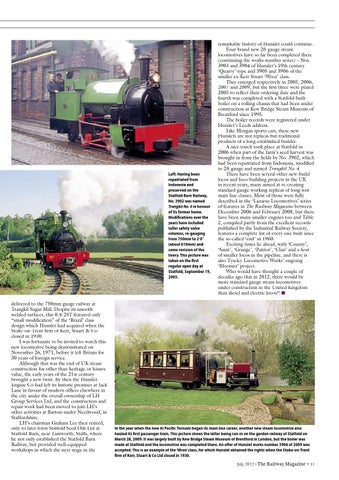Left: Having been repatriated from Indonesia and preserved on the Statfold Barn Railway, No. 3902 was named Trangkil No. 4 in honour of its former home. Modifications over the years have included taller safety valve columns, re-gauging from 750mm to 2’0" (about 610mm) and some revision of the livery. This picture was taken on the first regular open day at Statfold, September 19, 2005.
delivered to the 750mm gauge railway at Trangkil Sugar Mill. Despite its smooth welded surfaces, this 0-4-2ST featured only “small modification” of the ‘Brazil’ class design which Hunslet had acquired when the Stoke-on-Trent firm of Kerr, Stuart & Co closed in 1930. I was fortunate to be invited to watch this new locomotive being demonstrated on November 26, 1971, before it left Britain for 30 years of foreign service. Although that was the end of UK steam construction for other than heritage or leisure value, the early years of the 21st century brought a new twist. By then the Hunslet Engine Co had left its historic premises at Jack Lane in favour of modern offices elsewhere in the city under the overall ownership of LH Group Services Ltd, and the construction and repair work had been moved to join LH’s other activities at Barton-under-Needwood, in Staffordshire. LH’s chairman Graham Lee then retired, only to later form Statfold Seed Oils Ltd at Statfold Barn, near Tamworth, Staffs, where he not only established the Statfold Barn Railway, but provided well-equipped workshops in which the next stage in the
remarkable history of Hunslet could continue. Four brand new 2ft gauge steam locomotives have so far been completed there (continuing the works number series) – Nos. 3903 and 3904 of Hunslet’s 19th century ‘Quarry’-type and 3905 and 3906 of the smaller ex-Kerr Stuart ‘Wren’ class. They emerged respectively in 2005, 2006, 2007 and 2009, but the first three were plated 2005 to reflect their ordering date and the fourth was completed with a Statfold-built boiler on a rolling chassis that had been under construction at Kew Bridge Steam Museum of Brentford since 1995. The boiler records were registered under Hunslet’s Leeds address. Like Morgan sports cars, these new Hunslets are not replicas but traditional products of a long-established builder. A nice touch took place at Statfold in 2006 when part of the farm’s seed harvest was brought in from the fields by No. 3902, which had been repatriated from Indonesia, modified to 2ft gauge and named Trangkil No. 4. There have been several other new-build locos and loco-building projects in the UK in recent years, many aimed at re-creating standard gauge working replicas of long-lost main line classes. Most of those were fully described in the ‘Lazarus Locomotives’ series of features in The Railway Magazine between December 2006 and February 2008, but there have been many smaller engines too and Table 2, compiled partly from the excellent records published by the Industrial Railway Society, features a complete list of every one built since the so-called ‘end’ in 1960. Exciting times lie ahead, with ‘County’, ‘Saint’, ‘Grange’, ‘Patriot’, ‘Clan’ and a host of smaller locos in the pipeline, and there is also Tyseley Locomotive Works’ ongoing ‘Bloomer’ project. Who would have thought a couple of decades ago that in 2012, there would be more standard gauge steam locomotives under construction in the United Kingdom than diesel and electric locos?! ■
In the year when the new Al Pacific Tornado began its main line career, another new steam locomotive also hauled its first passenger train. This picture shows the latter being run-in on the garden railway at Statfold on March 28, 2009. It was largely built by Kew Bridge Steam Museum of Brentford in London, but the boiler was made at Statfold and the locomotive was completed there. An offer of Hunslet works number 3906 of 2009 was accepted. This is an example of the ‘Wren’ class, for which Hunslet obtained the rights when the Stoke-on-Trent firm of Kerr, Stuart & Co Ltd closed in 1930.
July 2012 • The Railway Magazine • 31
